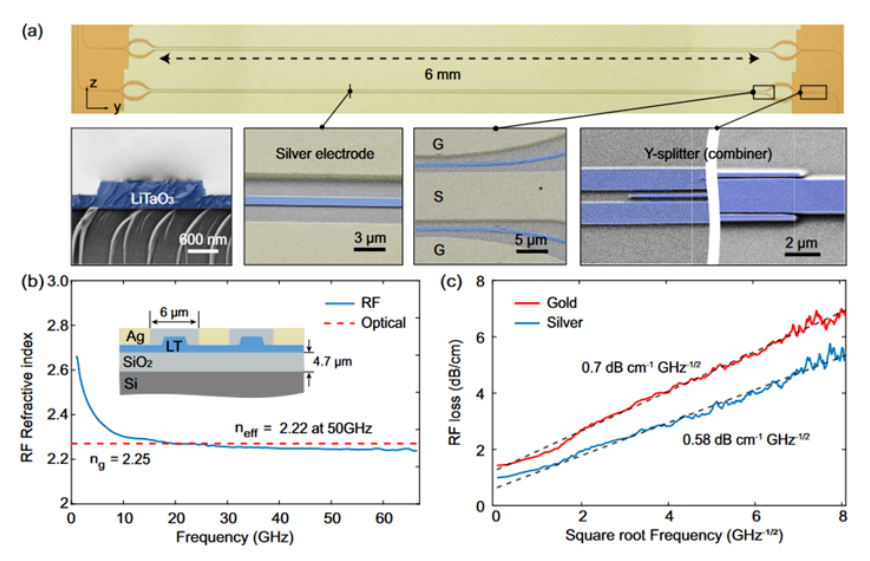Lithium tantalate (LTOI) high speed electro-optic modulator
Global data traffic continues to grow, driven by the widespread adoption of new technologies such as 5G and artificial intelligence (AI), which poses significant challenges for transceivers at all levels of optical networks. Specifically, the next generation electro-optic modulator technology requires a significant increase in data transfer rates to 200 Gbps in a single channel while reducing energy consumption and costs. In the past few years, silicon photonics technology has been widely used in the optical transceiver market, mainly due to the fact that silicon photonics can be mass-produced using the mature CMOS process. However, SOI electro-optic modulators that rely on carrier dispersion face great challenges in bandwidth, power consumption, free carrier absorption and modulation nonlinearity. Other technology routes in the industry include InP, thin film lithium niobate LNOI, electro-optical polymers, and other multi-platform heterogeneous integration solutions. LNOI is considered to be the solution that can achieve the best performance in ultra-high speed and low power modulation, however, it currently has some challenges in terms of mass production process and cost. Recently, the team launched a thin film lithium tantalate (LTOI) integrated photonic platform with excellent photoelectric properties and large-scale manufacturing, which is expected to match or even exceed the performance of lithium niobate and silicon optical platforms in many applications. However, until now, the core device of optical communication, the ultra-high speed electro-optic modulator, has not been verified in LTOI.
In this study, the researchers first designed the LTOI electro-optic modulator, the structure of which is shown in Figure 1. Through the design of the structure of each layer of lithium tantalate on the insulator and the parameters of the microwave electrode, the propagation speed matching of microwave and light wave in the electro-optical modulator is realized. In terms of reducing the loss of the microwave electrode, the researchers in this work for the first time proposed the use of silver as an electrode material with better conductivity, and the silver electrode was shown to reduce the microwave loss to 82% compared to the widely used gold electrode.

FIG. 1 LTOI electro-optic modulator structure, phase matching design, microwave electrode loss test.

FIG. 2 shows the experimental apparatus and results of the LTOI electro-optic modulator for intensity modulated direct detection (IMDD) in optical communication systems. The experiments show that the LTOI electro-optic modulator can transmit PAM8 signals at a sign rate of 176 GBd with a measured BER of 3.8×10⁻² below the 25% SD-FEC threshold. For both 200 GBd PAM4 and 208 GBd PAM2, BER was significantly lower than the threshold of 15% SD-FEC and 7% HD-FEC. The eye and histogram test results in Figure 3 visually demonstrate that the LTOI electro-optic modulator can be used in high-speed communication systems with high linearity and low bit error rate.
FIG. 2 Experiment using LTOI electro-optic modulator for Intensity modulated Direct Detection (IMDD) in optical communication system (a) experimental device; (b) The measured bit error rate (BER) of PAM8(red), PAM4(green) and PAM2(blue) signals as a function of the sign rate; (c) Extracted usable information rate (AIR, dashed line) and associated net data rate (NDR, solid line) for measurements with bit-error rate values below the 25% SD-FEC limit; (d) Eye maps and statistical histograms under PAM2, PAM4, PAM8 modulation.
This work demonstrates the first high-speed LTOI electro-optic modulator with a 3 dB bandwidth of 110 GHz. In intensity modulation direct detection IMDD transmission experiments, the device achieves a single carrier net data rate of 405 Gbit/s, which is comparable to the best performance of existing electro-optical platforms such as LNOI and plasma modulators. In the future, using more complex IQ modulator designs or more advanced signal error correction techniques, or using lower microwave loss substrates such as quartz substrates, lithium tantalate devices are expected to achieve communication rates of 2 Tbit/s or higher. Combined with LTOI’s specific advantages, such as lower birefringence and the scale effect due to its widespread application in other RF filter markets, lithium tantalate photonics technology will provide low-cost, low-power and ultra-high-speed solutions for next-generation high-speed optical communication networks and microwave photonics systems.
Post time: Dec-11-2024





